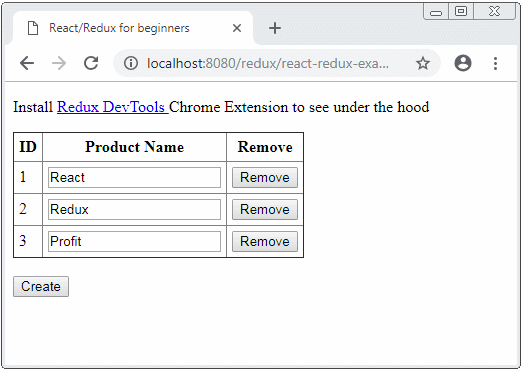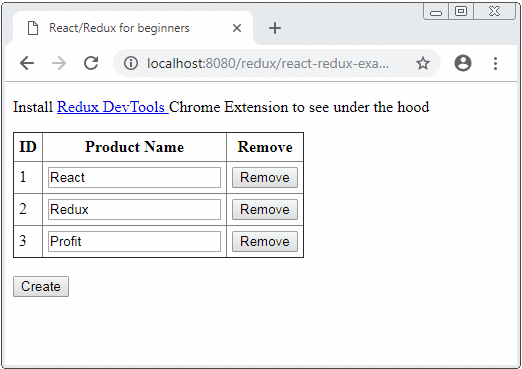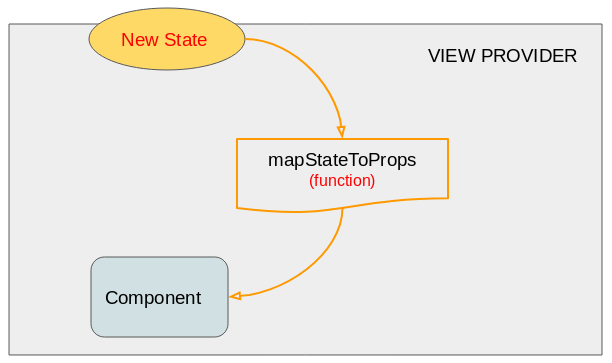Simple example with React and Redux on the client side
1. The Objectives of example
In the lesson, I will guide you to create a small application with the React & Redux, of which the Redux library helps to manage the state of application. This entire application runs at the Client Side.
Below is the Demo image of the application:

The libraries used in this application:
Libraries
<!--
NOTE: Check other version at: https://cdnjs.com
-->
<!-- React Libraries -->
<script src="https://cdnjs.cloudflare.com/ajax/libs/react/16.4.2/umd/react.production.min.js"></script>
<script src="https://cdnjs.cloudflare.com/ajax/libs/react-dom/16.4.2/umd/react-dom.production.min.js"></script>
<!-- Redux & React-Redux Libraries -->
<script src="https://cdnjs.cloudflare.com/ajax/libs/redux/4.0.0/redux.min.js"></script>
<script src="https://cdnjs.cloudflare.com/ajax/libs/react-redux/5.0.7/react-redux.min.js"></script>
<!-- Babel Library -->
<script src="https://cdnjs.cloudflare.com/ajax/libs/babel-standalone/6.26.0/babel.min.js"></script>The Architecture of Redux:
You can see my "Introduction about Redux" post based on the following link to understand the Redux more and its architecture as well as learning about the difference between the Flux and Redux.

2. Code of application
No ADS
Create 2 react-redux-example.html & react-redux-example.jsx files:
react-redux-example.html
<!DOCTYPE html>
<html>
<head>
<meta charset="UTF-8">
<title>React/Redux for beginners</title>
<!--
NOTE: Check other version at: https://cdnjs.com
-->
<!-- React Libraries -->
<script src="https://cdnjs.cloudflare.com/ajax/libs/react/16.4.2/umd/react.production.min.js"></script>
<script src="https://cdnjs.cloudflare.com/ajax/libs/react-dom/16.4.2/umd/react-dom.production.min.js"></script>
<!-- Redux & React-Redux Libraries -->
<script src="https://cdnjs.cloudflare.com/ajax/libs/redux/4.0.0/redux.min.js"></script>
<script src="https://cdnjs.cloudflare.com/ajax/libs/react-redux/5.0.7/react-redux.min.js"></script>
<!-- Babel Library -->
<script src="https://cdnjs.cloudflare.com/ajax/libs/babel-standalone/6.26.0/babel.min.js"></script>
<style>
table {
border-collapse: collapse;
}
table td, th {
padding: 5px;
}
</style>
</head>
<body>
<p>Install
<a target="_blank"
href="https://chrome.google.com/webstore/detail/redux-devtools/lmhkpmbekcpmknklioeibfkpmmfibljd/related?hl=en">
Redux DevTools
</a>
Chrome Extension to see under the hood
</p>
<div id="app">
Loading...
</div>
<script type="text/babel" src="react-redux-example.jsx"></script>
</body>
</html>react-redux-example.jsx
// REACT COMPONENT
// Generally you would spilt this up into logical components
// and pass props around correctly etc but we are keeping it as simply as possible
class ProductsPane extends React.Component {
constructor (props, context) {
super(props, context);
}
// EVENT HANDLERS
// They are responsible for calling `dispatch` which will send events to redux
addProduct = () => {
var action = {
type: 'ADD_PRODUCT'
};
this.props.dispatch(action);
}
removeProduct = (productId) => {
var action = {
type: 'REMOVE_PRODUCT',
productId: productId
};
this.props.dispatch(action);
}
editProduct = (productId, event) => {
var newName = event.target.value;
var action = {
type: 'EDIT_PRODUCT',
data: {
productId: productId,
productName: newName
}
};
this.props.dispatch(action);
}
render () {
const products = this.props.products;
// Example product: { productId : 4 , productName :'Profit' }
var trList = products.map( (product, index) => {
return (<tr key={product.productId}>
<td>{product.productId}</td>
<td><input type="text" onChange={this.editProduct.bind(null, product.productId)} value={product.productName} /></td>
<td>
<button onClick={this.removeProduct.bind(null, product.productId)}>
Remove
</button>
</td>
</tr>);
});
return (<div>
<table border="1">
<thead>
<th>ID</th>
<th>Product Name</th>
<th>Remove</th>
</thead>
<tbody>
{trList}
</tbody>
</table>
<br/>
<button onClick={this.addProduct}>
Create
</button>
</div>);
}
}
var nextProductId = 10;
// MAP STATE TO PROPS
// Probably the most important method of the demo which handles the React/Redux integration.
// When state changes, this method is called, which then you can use to customly
// map the state into props that your React component can use
// MAP: state.productList <==> props.products
const mapStateToProps = (state) => {
return {
products: state.productList
}
}
// Example product: { productId : 4 , productName :'Profit' }
const getIndexByProductId = (products, productId) => {
for(var i = 0; i < products.length; i++) {
var product = products[i];
if(product.productId === productId) {
return i;
}
}
return -1;
};
// REDUCERS
// Reducers listen for actions that are dispatched and react depending on your logic
// All state in Redux is immutable(never changes) so we always have to return a new
// state object.
// We are going to copy the current state and return a new one based off the action creators above
const appReducer = (state = {productList: []}, action) => {
// Clone Array.
let products = state.productList.slice();
// This is quite a common way of deciding which event to process
// Note: ALL events will be coming through this reducer
console.log('Actions', action); // Open your console to see what actions look like
// Even better, install Redux DevTools and your mind will be blown
switch (action.type) {
case 'ADD_PRODUCT':
nextProductId++;
var product = {productId : nextProductId, productName: "" };
products.push(product);
break;
case 'REMOVE_PRODUCT':
var idx = getIndexByProductId(products, action.productId);
if(idx != -1) {
products.splice(idx, 1); // Removes element at `idx`
}
break;
case 'EDIT_PRODUCT':
var idx = getIndexByProductId(products, action.data.productId);
if(idx != -1) {
products[idx].productName = action.data.productName;
}
break;
}
// As above, we have to return a new state object each time (Redux store is immutable)
// It makes sure we know our data can only be modified in one visible way
// Also lets us time travel through our application state!
const newState = {
productList: products
}
console.log('Current State', newState);
return newState;
}
// REDUX STORE
// Create store initializes our Redux store and only has to be called once
// The first argument is our `appReducer` defined above, it is almost like a listener
// The second is just our initial state which is just a Javascript object
// The third is usually where enhancers/middleware goes
// In this example it just loads Redux DevTools so everyone can play around
let store = Redux.createStore(appReducer, {
productList: [
{ productId : 1 , productName :'React' },
{ productId : 2 , productName :'Redux' },
{ productId : 3 , productName :'Profit' }
]
}, window.devToolsExtension ? window.devToolsExtension() : undefined);
// We want to use Redux connect to attach our mapStateToProps to our ProductsPane (React Component)
const MyApp = ReactRedux.connect (
mapStateToProps
)(ProductsPane);
// Render
ReactDOM.render(
<ReactRedux.Provider store={store}>
<MyApp />
</ReactRedux.Provider>,
document.getElementById('app')
);
if (window.devToolsExtension) {
window.devToolsExtension.open();
}Run the react-redux-example.html file on HTTP Server:

3. Explain the code of the application
No ADS
OK, In this application, we use the React and Redux, of which, the Redux is a Javascript library to help to manage the state of application. The following figure illustrates the architecture of Redux.

When the user interacts with the application's interface (for example, clicking), a method of the Component will be called to execute. In this method, an action object is created, which is a pure object, containing the information related to events and statuses to be updated. Finally, send this object to STORE by calling this.props.dispatch(action).

REDUCER: a Javascript function and you have to write code for this function to return a new state for the application. It has 2 parameters:
- Parameter 1: Initial state of application.
- Parameter 2: The action object is sent from the previous step.
In Redux, STORE is only. It stores the state of application and contains Reducers and Middlewares. You can create a STORE via the Redux.createStore(..) method.
// createStore method:
Redux.createStore(reducer, [preloadedState], [enhancer])
// @see API docs: https://redux.js.org/api/createstore
After the action is handled on STORE, a new state is returned to VIEW PROVIDER.

The new state is updated for Component:


No ADS
ReactJS Tutorials
- ReactJS props and state Tutorial with Examples
- ReactJS Events Tutorial with Examples
- ReactJS Component API Tutorial with Examples
- ReactJs component Lifecycle methods
- ReactJS Refs Tutorial with Examples
- ReactJS Lists and Keys Tutorial with Examples
- ReactJS Forms Tutorial with Examples
- Undertanding ReactJS Router with example on the client side
- Introduction to Redux
- Simple example with React and Redux on the client side
- React-Transition-Group API Tutorial with Examples
- Quickstart with ReactJS in NodeJS Environment
- Undertanding ReactJS Router with a basic example (NodeJS)
- React-Transition-Group Transition Example (NodeJS)
- React-Transition-Group CSSTransition Example (NodeJS)
- Introduction to ReactJS
- Install React Plugin for Atom Editor
- Create a Simple HTTP Server with NodeJS
- Quickstart with ReactJS - Hello ReactJS
Show More